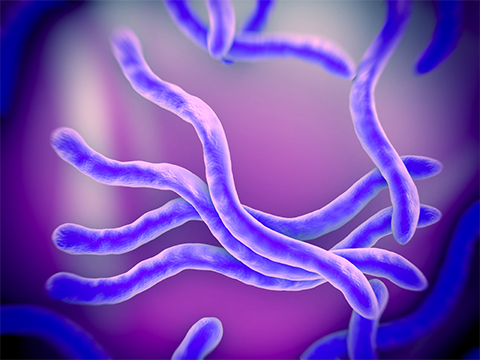From the journals: JBC
Lyme disease pathogen evades host immunity. Transporters unite to assist cancer cells. How a fungal pore protein assembles. Read about these papers recently published in the Journal of Biological Chemistry.
Lyme disease pathogen evades host immunity

Lyme disease is an infection that spreads through the bite of a tick infected with the bacteria Borrelia burgdorferi. To cause infection, B. burgdorferi must evade host innate immunity, which includes a first line of defense called the complement system. This system is initiated by proteins known as proteases that set off a cascade that activates complexes important for recognition and destruction of pathogens. B. burgdorferi contains outer surface lipoproteins, such as ElpQ, that inhibit these complement proteases, but scientists are still working out the details of this mechanism.
In a recent paper in the Journal of Biological Chemistry, Sheila Thomas and colleagues from East Carolina University and Tufts University examined the structure of ElpQ and ElpQ bound to the complement protease C1s. They used hydrogen-deuterium exchange mass spectrometry, a technique that provides solution structure information, to identify potential binding sites on ElpQ. Guided by this structural information, they also mutated residues of ElpQ and used surface plasmon resonance to test the ability of the variants to bind to C1s and another complement protease, C1r. These experiments helped pinpoint residues in the C-terminal region of ElpQ that are essential for the interaction with proteases and highlighted a role for a tyrosine residue that is conserved between ElpQ and another Elp protein family member.
These findings contribute to a larger investigation of how bacterial outer surface proteins inhibit complement system components and further illustrate the specific mechanism used by B. burgdorferi to evade host immunity. Scientists may find ways to use this information in future studies to guide the design of Elp family outer surface protein inhibitors to treat Lyme disease.
Transporters unite to assist cancer cells
Cancer cells can overexpress transporter proteins as a way to remove chemotherapeutics, leading to multidrug resistance and poor prognosis. Some of these transporters can protect cancer cells against other stresses such as radiation, although researchers still know little about the mechanisms by which they accomplish this.
Jia Shi and colleagues from Rutgers University examined whether ABCG2 interacts with other proteins to boost cancer cell survival. They recently published their results in the Journal of Biological Chemistry and defined an interaction between ABCG2 and another membrane protein, solute carrier 1, family 5 or SLC1A5. The authors identified SLC1A5, the main glutamine transporter in tumor cells, by examining breast adenocarcinoma cells using immunoprecipitation and mass spectrometry. Further experiments showed that ABCG2 increases tumor cell glutamine uptake through SLC1A5 to feed the tricarboxylic acid cycle, which enhances cellular metabolite production. The researchers also found that this increase in glutamine ramped up production of glutathione, an antioxidant that can combat free radicals.
Further work is needed to determine a mechanism for this interaction, but these results may lead researchers to investigate possible combination therapies targeting both ABCG2 and SLC1A5 in tumors. In addition, these findings indicate that ABCG2 may have an impact on glutamine metabolism beyond cancer cells.
How a fungal pore protein assembles
The fungus Candida albicans is a common commensal resident of the human gut. Upon gut microbiota imbalance or immune system suppression, C. albicans can undergo a morphological transition to an invasive form that causes the infection candidiasis. In this invasive form, C. albicans expresses a pore-forming peptide called candidalysin that wreaks havoc on the host’s epithelial cell membranes. Finding a way to disrupt candidalysin may provide an avenue for selectively treating candidiasis without using broad-spectrum antifungals, which can harm beneficial gut microbes.
To form an active pore, candidalysin first polymerizes in solution, but scientists do not fully understand this mechanism. So, Katherine Schaefer, Boomer Russell and colleagues at the University of Missouri and the University of Tennessee used biophysical tools to clarify this process in a recent publication in the Journal of Biological Chemistry. They identified four events that occur when the peptide polymerizes. First, the monomer peptide oligomerizes to form octamers that then join to make a longer chain. Three different events proceed from this chain: chain extension, chain branching and cyclization, which forms the destructive pore.
Additional studies will elucidate what conditions stabilize the cyclized polymer. These results may help researchers identify ways to dismantle candidalysin assembly to protect host cell membranes and specifically target C. albicans infection.
Enjoy reading ASBMB Today?
Become a member to receive the print edition four times a year and the digital edition monthly.
Learn moreGet the latest from ASBMB Today
Enter your email address, and we’ll send you a weekly email with recent articles, interviews and more.
Latest in Science
Science highlights or most popular articles

Bacteriophage protein could make queso fresco safer
Researchers characterized the structure and function of PlyP100, a bacteriophage protein that shows promise as a food-safe antimicrobial for preventing Listeria monocytogenes growth in fresh cheeses.

Building the blueprint to block HIV
Wesley Sundquist will present his work on the HIV capsid and revolutionary drug, Lenacapavir, at the ASBMB Annual Meeting, March 7–10, in Maryland.

Gut microbes hijack cancer pathway in high-fat diets
Researchers at the Feinstein Institutes for Medical Research found that a high-fat diet increases ammonia-producing bacteria in the gut microbiome of mice, which in turn disrupts TGF-β signaling and promotes colorectal cancer.

Mapping fentanyl’s cellular footprint
Using a new imaging method, researchers at State University of New York at Buffalo traced fentanyl’s effects inside brain immune cells, revealing how the drug alters lipid droplets, pointing to new paths for addiction diagnostics.

Designing life’s building blocks with AI
Tanja Kortemme, a professor at the University of California, San Francisco, will discuss her research using computational biology to engineer proteins at the 2026 ASBMB Annual Meeting.

Cholesterol as a novel biomarker for Fragile X syndrome
Researchers in Quebec identified lower levels of a brain cholesterol metabolite, 24-hydroxycholesterol, in patients with fragile X syndrome, a finding that could provide a simple blood-based biomarker for understanding and managing the condition.

